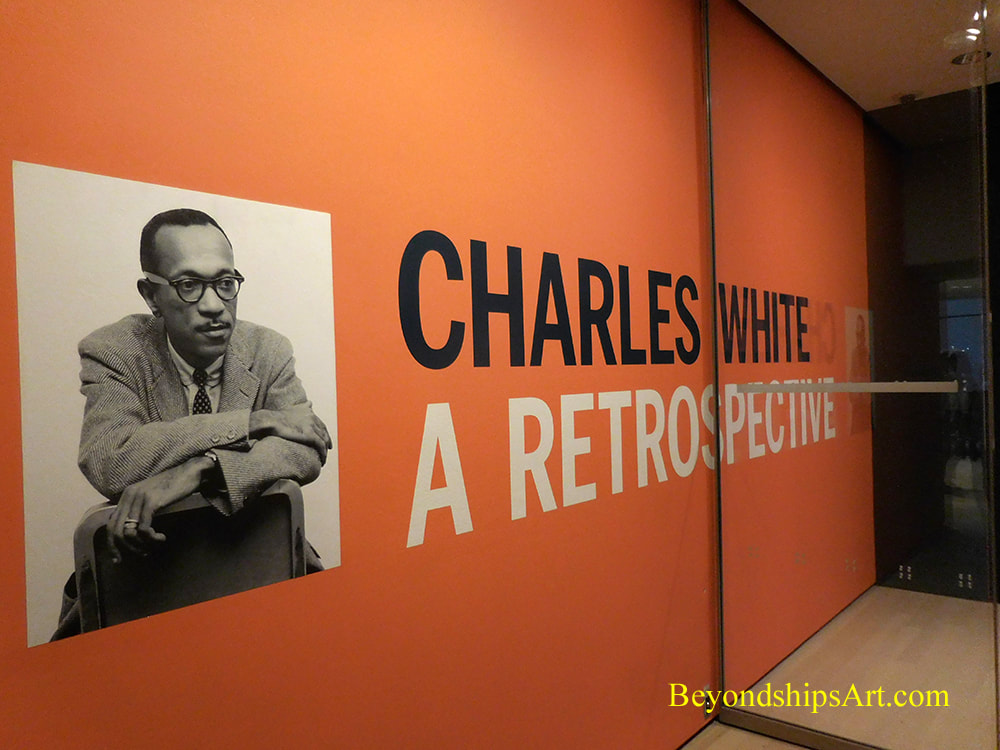ART REVIEW: "CHARLES WHITE: A RETROSPECTIVE" “Charles White: A Retrospective” at the Museum of Modern Art surveys the work of the 20th century African American artist Charles White. It includes some 100 paintings, drawings and prints as well as ephemera from his career. Reflecting the fact that White's career unfolded principally in Chicago, New York and Los Angles, this exhibition was first shown at the Art Institute of Chicago and will be shown at the Los Angles County Museum of Art following its showing at MOMA.
Charles White was born in 1918. Because his parents could not afford babysitters, they often left Charles at the library when they went off to work. As a result, Charles developed a passion for reading and art at an early age. When he was seven, his mother gave him a set of oil paints. She also would take him to the Art Institute of Chicago to look at the paintings. This cemented his commitment to becoming an artist. White's formal training as an artist came mostly from the Art Institute of Chicago. At first, he attended weekend classes but later won a scholarship to attend as a full time student. He worked as a cook to earn the money to pay for his art materials. Later, he became an art teacher at a Catholic high school. Meanwhile, White was developing a social awareness. He questioned his teachers in school about why no African Americans were among the people being studied. Disillusioned by the teaching system, he refused to attend classes. After the death of his father, his mother remarried but her new husband was alcoholic and abusive towards Charles. Around the same time, his mother began sending Charles to live with relatives in Mississippi each summer. As a result, he experienced what it was like to be black in the Deep South in the early 20th century. After graduating from the School of the Art Institute of Chicago, White went to work making paintings for the WPA Federal Arts Project. This project was part of the Depression-era relief program, the Works Project Administration and is best known for the murals that its artists produced for post offices and public buildings. White's first major work was a mural “Five Great American Negroes,” a tableau of African American history. White went on to become a successful and established artist within his lifetime. He exhibited in major museums such as the Boston Museum of Fine Art and the Whitney Museum of American Art. White was also represented by art galleries and did art for various publications and for record album covers. Towards the end of his career, he taught art at the Otis Art Institute in Los Angles where he encouraged and inspired a new generation of artists. As the exhibition documents, White placed his art at the service of political and social causes. “Art must be an integral part of the struggle,” he said “It can’t simply mirror what’s taking place. … It must ally itself with the forces of liberation.” Therefore, his images tackle such things as discrimination, poverty, unfair labor practices and other injustices. His “images of dignity” challenge the stereotypes that helped to subordinate black people. White also went against the mainstream in another way. At the time that White was working, the art establishment was only interested in abstract works. White adhered to traditional techniques and created figurative images. Nonetheless, he was able to achieve success. In addition to being an excellent draftsman, White was able to capture emotion. Of course, the political and social issues he dealt with are charged with emotion. However, even at some point in the future when discrimination is no longer an issue, the people depicted in White's works will still be able to move viewers. |
|
Art review - Museum of Modern Art - "Charles White: A Retrospective"
